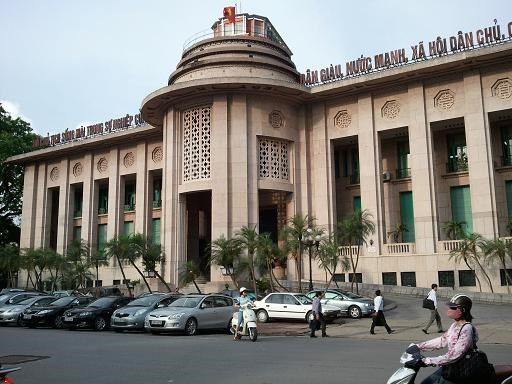Central bank to keep monetary policy on hold through 2019
The State Bank of Vietnam (SBV) will hold its benchmark refinancing and discount rates at 6.25 percent and 4.25 percent, respectively, in addition to maintaining its 14 percent credit growth target for the remainder of 2019, experts forecast.
 Headquarters of the State Bank of Vietnam in Hanoi (Photo: VNA)
Headquarters of the State Bank of Vietnam in Hanoi (Photo: VNA)Hanoi (VNS/VNA) - The State Bank of Vietnam (SBV) will hold its
benchmark refinancing and discount rates at 6.25 percent and 4.25 percent,
respectively, in addition to maintaining its 14 percent credit growth target
for the remainder of 2019, experts forecast.
“We expect the SBV to keep its monetary policy on hold for the remainder of 2019. Monetary policy transmission in Vietnam remains weak and this informs our view for the SBV to continue to manage financial risks through non-interest rate measures such as loan directives and macro-prudential measures,” analysts from Fitch Solutions told Vietnam News.
On the one hand, the analysts said, Vietnam’s five-year government bond yield stands at 3.85 percent, below the SBV’s discount rate of 4.25 percent, and this continues to suggest that monetary policy transmission is still not optimal due to excess liquidity in the banking system.
In addition, bank lending rates are high and appear to be on an upwards trend. For example, interest rates at Techcombank are between 6.80 percent and 9.83 percent on large VNĐ-denominated corporate loans in June, compared to between 6.40 percent and 9.00 percent in March. Moreover, high deposit interest rates at 6.80 percent for tenures above 12 months for both Agribank and Vietcombank also suggest that lending interest rates are likely to be high at these banks.
Speaking about monetary policy in the second half of this year, SBV Deputy Governor Nguyen Thi Hong said the SBV would continue to follow a pro-active, flexible and cautious monetary policy as well as working in close conjunction with fiscal and other policies to control inflation, sustain the macro-economy and support economic growth.
According to Fitch analysts, macro-prudential measures will continue to be the method of choice for the SBV over the coming quarters to manage financial stability risks in the economy.
Under the SBV’s regulations, the proportion of short-term capital to be used for medium and long term lending by banks has to be reduced to 40 percent in 2019 from 45 percent in 2018. This has already seen some smaller and less well-capitalised banks raise interest rates offered on long-term time deposits since the first quarter of this year with the aim of attracting the capital needed to meet this requirement.
In June, the SBV released a draft circular seeking public comments on further macro-prudential measures the central bank intends to introduce to manage financial risks in the economy, with a specific focus on managing the risk of lending to the real estate segment.
The circular encompassed a number of changes, including a further reduction to the ratio of short-term capital for medium and long term loans to 30 percent by July 1, 2020, with the aim of helping the central bank manage liquidity risks in the banking sector. To be sure, this regulatory change would apply to loans in all sectors and not just the real estate sector.
Other regulatory changes proposed include raising the risk weight ratio for home purchase loans worth 3 billion VND and above and loans worth between 1.5 billion VND and 3 billion VND at 150 percent and 100 percent, respectively, from 50 percent at present. Housing mortgage loans worth less than 1.5 billion VND and loans for the purchase of social and government supported housing projects will remain at the risk weight ratio of 50 percent.
According to the SBV, the aim of these changes is to channel real estate credit toward borrowers with genuine housing needs instead of speculators and to balance the development of low-cost commercial and social housing as demand in the low-cost segment still outstrips supply.
Fitch analysts also expect the SBV to focus efforts on banking sector reforms, explaining this was because credit growth was one of the SBV’s main monetary policy tools.
The SBV tailors credit growth quotas for each bank, with healthier banks (assessed based on the bank’s operations and ability to grow credit sustainably) being assigned a higher quota, vice versa, with the aim of regulating overall credit growth within its annual target.
The SBV has so far also instructed credit institutions to implement a host of administrative reforms over the past couple of years, which include the simplification of borrowing procedures, the provision of adequate guidance for borrowers, and the improvement of restructuring plans associated with the handling of bad debt.
"We believe that a strengthening of credit institutions and a stronger lending framework as a result of the Government's continued pursuit of banking sector reforms will support more sustainable credit growth over the long term," Fitch analysts said.-VNS/VNA
“We expect the SBV to keep its monetary policy on hold for the remainder of 2019. Monetary policy transmission in Vietnam remains weak and this informs our view for the SBV to continue to manage financial risks through non-interest rate measures such as loan directives and macro-prudential measures,” analysts from Fitch Solutions told Vietnam News.
On the one hand, the analysts said, Vietnam’s five-year government bond yield stands at 3.85 percent, below the SBV’s discount rate of 4.25 percent, and this continues to suggest that monetary policy transmission is still not optimal due to excess liquidity in the banking system.
In addition, bank lending rates are high and appear to be on an upwards trend. For example, interest rates at Techcombank are between 6.80 percent and 9.83 percent on large VNĐ-denominated corporate loans in June, compared to between 6.40 percent and 9.00 percent in March. Moreover, high deposit interest rates at 6.80 percent for tenures above 12 months for both Agribank and Vietcombank also suggest that lending interest rates are likely to be high at these banks.
Speaking about monetary policy in the second half of this year, SBV Deputy Governor Nguyen Thi Hong said the SBV would continue to follow a pro-active, flexible and cautious monetary policy as well as working in close conjunction with fiscal and other policies to control inflation, sustain the macro-economy and support economic growth.
According to Fitch analysts, macro-prudential measures will continue to be the method of choice for the SBV over the coming quarters to manage financial stability risks in the economy.
Under the SBV’s regulations, the proportion of short-term capital to be used for medium and long term lending by banks has to be reduced to 40 percent in 2019 from 45 percent in 2018. This has already seen some smaller and less well-capitalised banks raise interest rates offered on long-term time deposits since the first quarter of this year with the aim of attracting the capital needed to meet this requirement.
In June, the SBV released a draft circular seeking public comments on further macro-prudential measures the central bank intends to introduce to manage financial risks in the economy, with a specific focus on managing the risk of lending to the real estate segment.
The circular encompassed a number of changes, including a further reduction to the ratio of short-term capital for medium and long term loans to 30 percent by July 1, 2020, with the aim of helping the central bank manage liquidity risks in the banking sector. To be sure, this regulatory change would apply to loans in all sectors and not just the real estate sector.
Other regulatory changes proposed include raising the risk weight ratio for home purchase loans worth 3 billion VND and above and loans worth between 1.5 billion VND and 3 billion VND at 150 percent and 100 percent, respectively, from 50 percent at present. Housing mortgage loans worth less than 1.5 billion VND and loans for the purchase of social and government supported housing projects will remain at the risk weight ratio of 50 percent.
According to the SBV, the aim of these changes is to channel real estate credit toward borrowers with genuine housing needs instead of speculators and to balance the development of low-cost commercial and social housing as demand in the low-cost segment still outstrips supply.
Fitch analysts also expect the SBV to focus efforts on banking sector reforms, explaining this was because credit growth was one of the SBV’s main monetary policy tools.
The SBV tailors credit growth quotas for each bank, with healthier banks (assessed based on the bank’s operations and ability to grow credit sustainably) being assigned a higher quota, vice versa, with the aim of regulating overall credit growth within its annual target.
The SBV has so far also instructed credit institutions to implement a host of administrative reforms over the past couple of years, which include the simplification of borrowing procedures, the provision of adequate guidance for borrowers, and the improvement of restructuring plans associated with the handling of bad debt.
"We believe that a strengthening of credit institutions and a stronger lending framework as a result of the Government's continued pursuit of banking sector reforms will support more sustainable credit growth over the long term," Fitch analysts said.-VNS/VNA













